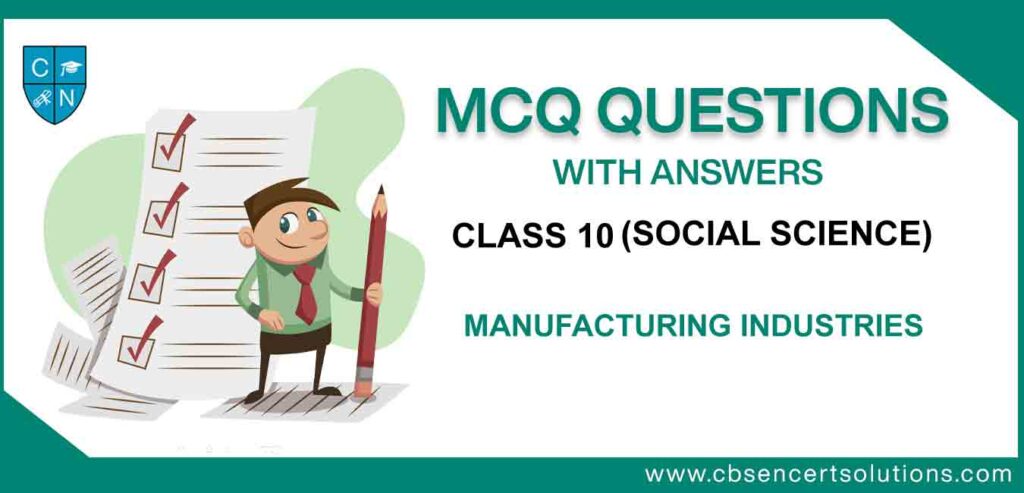Check the below NCERT MCQ Class 10 Social Science Manufacturing Industries with Answers available with PDF free download. MCQ Questions for Class 10 Social Science with Answers were prepared based on the latest syllabus and examination pattern issued by CBSE, NCERT and KVS. Our teachers have provided below Manufacturing Industries Class 10 Social Science MCQs Questions with answers which will help students to revise and get more marks in exams
Manufacturing Industries Class 10 Social Science MCQs Questions with Answers
Refer below for MCQ Class 10 Social Science Chapter 6 Manufacturing Industries with solutions. Solve questions and compare with the answers provided below.
Question. The backbone of economic development is
(a) agriculture sector.
(b) manufacturing sector.
(c) corpoarate sector.
(d) banking sector.
Answer
B
Question. Ranchi in Jharkhand is famous for
(a) petrochemical industry.
(b) ship building industry.
(c) heavy engineering and machine tool industry.
(d) cotton industry.
Answer
C
Question. Industries owned and operated by an individual or a group of individuals are called
(a) joint sector industries.
(b) private sector industries.
(c) public sector industries.
(d) cooperative sector industries.
Answer
B
Question. The common factor among cotton textile industry, sugar industry and jute industry is that all are
(a) mineral-based industries.
(b) agro-based industries.
(c) information technology industries.
(d) privately owned industries.
Answer
B
Question. What is the share of manufacturing industry in GDP of India.
(a) 27%
(b) 17%
(c) 20%
(d) 30%
Answer
A
Question. The first successful textile mill was established in Mumbai in the year
(a) 1824.
(b) 1854.
(c) 1864.
(d) 1884.
Answer
B
Question. Regular supply of electricity and an assured source of raw material at minimum cost are the two prime factors for the location of which one of the following industries:
(a) Iron and Steel
(b) Automobile
(c) Aluminium smelting
(d) Electronics
Answer
C
Question. Where was the first Cement Plant set up in India ?
(a) Mumbai
(b) Kolkata
(c) Chennai
(d) Delhi
Answer
C
Question. Which is not forest based Industry:
(a) Paper Industry
(b) Wood Industry
(c) Rubber Industry
(d) Sugar Industry
Answer
D
Question. Which one of the following industries uses limestone as a raw material?
(a) Iron and steel
(b) Sugar
(c) Cement
(d) Handloom
Answer
C
Question. In which year was the first successful cotton textile mill established in India ?
(a) 1853
(b) 1854
(c) 1855
(d) 1856.
Answer
B
Question. What are the Human factors for establishment of an industry :-
Factors :-
I. Labour
II. Raw Material
III. Transport
IV. Banking facilities
V. Availability of water
Select the correct answer from the following options :-
(a) I, III & IV
(b) I, II & III
(c) I, III & V
(d) I, II & V
Answer
A
Question. The industry that brought forward more manufacturer in recent years by Foreign Direct Investment (FDI) is
(a) electronic industry.
(b) cement industry.
(c) automobile industry.
(d) oil industry.
Answer
C
Question. Which one of the following industries boomed after the Green Revolution in India ?
(a) Cement industry
(b) Fertilizer industry
(c) Automobile industry
(d) Sugar industry
Answer
B
Question. The city in punjab that will soon be developed as major IT centre is
(a) Chandigarh.
(b) Bhatinda.
(c) Mohali.
(d) Pinjore.
Answer
A
Question. Which one of the following manufacturing industries provides employment to millions in India?
(a) Iron and Steel
(b) Petroleum
(c) Cotton-textile
(d) Cement
Answer
C
Question. The following is the list of rion and steel plants located in various parts of India.
A. Vishakhapatnam
B. Bhadravati
C. Jamshedpur
D. Salem
E. Rourkela
F. Bokaro
G. Vijayanagar
H. Durgapur
Which one of the following represents iron & steel industries located outside the Chotanagpur region ?
(a) A.D.G.H
(b) B.C.F.G
(c) A.B.D.G
(d) B.E.G.H
Answer
C
Question. Assertion (a) : Cotton textile industry is decentralised in India :
Reason (R) : Cotton textile industry is immensely influenced by market.
Select the correct option from the given alternatives –
(a) Both (a) and (R) are true, and (R) explains (a)
(b) Both (a) and (R) are true but (R) does not explain(a)
(c) (a) is true and (R) is false
(d) (a) is false and (R) is-true
Answer
C
Question. Which one of the following places has woolen and silk textile industry combined ?
(a) Varanasi
(b) Srinagar
(c) Mirzapur
(d) Agra
Answer
B
Question. Ranchi in Jharkhand is famous for
(a) petrochmical industry.
(b) electronic industry.
(c) heavy engineering.
(d) ship building.
Answer
C
Question. Which one of the following groups of states have the largest number of cotton textile centres ?
(a) Gujarat and Maharashtra
(b) Karnataka and Tamil Nadu
(c) Maharashtra and Madhya Pradesh
(d) Uttar Pradesh and Gujarat
Answer
B
Question. Which one of the following steel plants is located in Chhattisgarh ?
(a) Bokaro
(b) Durgapur
(c) Bhilai
(d) Rourkela
Answer
C
Question. Which one of the following industries use bauxite as a raw material.
(a) Electronics
(b) Cement
(c) Aluminium
(d) Steel
Answer
C
Question. Which of the following industrial towns is located on the Chhotanagpur Plateau ?
(a) Chennai
(b) Ranchi
(c) Srinagar
(d) Sundernagar
Answer
B
Question. Most of the sugar industries are ideally suited to :
(a) Private sector
(b) Joint sector
(c) Cooperative sector
(d) Public sector
Answer
C
Question. Which is the largest Paper producing State in India –
(a) Andhra Pradesh
(b) Maharastra
(c) West Bengal
(d) Orissa
Answer
C
Question. Choose the right answer
A. Cottonopolice of India – Mumbai
B. Silicon valley of India – Bangalore
C. Manchester of North India-Kanpur
D. Detroit of India – Modi Nagar
(a) All the options are right
(b) Only B and D are right
(c) Only A and B are right
(d) Only A, B and C are right
Answer
D
Question. TISCO is the type of
(a) agrobased industry.
(b) Ownership.
(c) Mineral based industry.
(d) IT based industry.
Answer
C
Question. Read the following statement :
A. Cottage industrial occupations are hereditary in nature.
B. Some of the goods produced in cottage industries, are also exported.
C. Cottage industires adopt high level of technology and required huge capital.
Which of the followig is correct ?
(a) ‘A’ is true and B and C are false
(b) ‘A’ is false and B & C are true
(c) ‘B’ is true and A & C are false
(d) ‘C’ is false and A & B are true
Answer
D
Question. Consider the following statements :
Assertion (a) : Manganese is used in the manufacturing of steel.
Reason (R) : Nearly 10 kilogram of manganese is needed to make one tonne of steel.
Select the correct option from the given alternatives.
(a) (a) is true, but (R) is false
(b) Both (a) and (R) are true and (R) is the correct explanation of (a)
(c) Both (a) and (R) are true, but (R) is not the correct explanation of (a)
(d) Both (a) and (R) are false.
Answer
B
Question. The economic strength of the country is measured by which of the following developments ?
(a) The development of the manufacturing industries.
(b) The development of the literacy ratio.
(c) The development of the health status.
(d) The development of the population growth.
Answer
A
Question. On the basis of bulk raw material and finished goods,Oil is a basic raw material for
(a) automobiles.
(b) sewing machines.
(c) paint brushes.
(d) electric bulbs.
Answer
A
Question. Which one of the following agencies market steel for the public sector plants?
(a) HAIL
(b) SAIL
(c) TATA STEEL
(d) MNCC
Answer
B
Question. Maruti Udyog Limited is an example of which type of industry ?
(a) Joint sector
(b) Public sector
(c) Private sector
(d) Co-operative sector
Answer
A
Question. The rank of India in the capacity of spindles in the world stands at
(a) First position.
(b) Second position.
(c) Third position.
(d) Fourth position.
Answer
B
Question. What is the correct meaning of agglomeration economies?
(a) Many industries set up in rural centres
(b) Industries are basically agro-based.
(c) Many industries tend to come together to make use of the advantages offered by the urban centres
(d) Industries set up produce raw material for secondary sector.
Answer
C
Question. Which one of the following is not true regarding the Iron and Steel industry in India?
(a) India is the largest producer of sponge iron.
(b) Most of the public sector undertakings market their steel through the Steel Authority of India.
(c) Chhotanagpur Plateau region has the maximum concentration of iron and steel industries.
(d) As a leading iron and steel producing country, India does not need to import steel from other countries.
Answer
D
Question. The areas with concentration of jute mills in India are
(a) Maharashtra.
(b) Gujarat.
(c) Banks of Hoogli river, West Bengal.
(d) Uttar Pradesh.
Answer
C
Question. Organic and inorganic industrial wastes and affluent discharged into rivers and water bodies causes
(a) water pollution.
(b) air pollution.
(c) noise pollution.
(d) land pollution.
Answer
A
Question. Which one of the following air services provides services to Oil and Natural Gas Commission in its off-shore operations ?
(a) Indian Airlines
(b) Air India
(c) Pawanhans Helicopters LTD
(d) Alliance
Answer
C
Question. Textile industry is an example of :
(a) Agro based industry
(b) Co-operative sector industry
(c) Mineral based industry
(d) Marine based industry
Answer
A
Question. Which one of the following factors has once again opened the opportunity for jute product?
(a) Increasing concern for the use of biodegradable materials
(b) Increasing productivity
(c) Enhancing the yield per hectare
(d) Improving quality
Answer
A
Question. Which one of the following iron and steel plant was established during third five year plan ?
(a) Bhilai
(b) Bokaro
(c) Rurkela
(d) Durgapur
Answer
B
FILL IN THE BLANKS
Question. Since 2003 indistrial growth is between ________ to ________ percent per annum.
Answer
9 & 10
Question. Manufacturing sector share ________ percent in GDP.
Answer
17
Question. The first successful textile mill was established in mumbai in ________ .
Answer
1854
Question. ________ city is famous for iron & steel plants in Chattisgarh.
Answer
Bhilai
Question. Basic and consumer industies are classified on the base of ________.
Answer
role
TRUE / FALSE
Question. In 1984, India’s first cement plant was established in Chennai.
Answer
True
Question. India has the second largest intalled capacity of spindles in the world after China.
Answer
True
Question. (Software Technology Parks of India) has come up accross 46 location at different centres of India.
Answer
True
Question. India is the largest producer of raw jute and jute goods.
Answer
True

We hope you liked MCQ Class 10 Social Science Manufacturing Industries with answers provided above. Incase you have any questions please post them in the comments section below and our Social Science teachers will provide a response.

